#Joh. Enschedé
Explore tagged Tumblr posts
Text
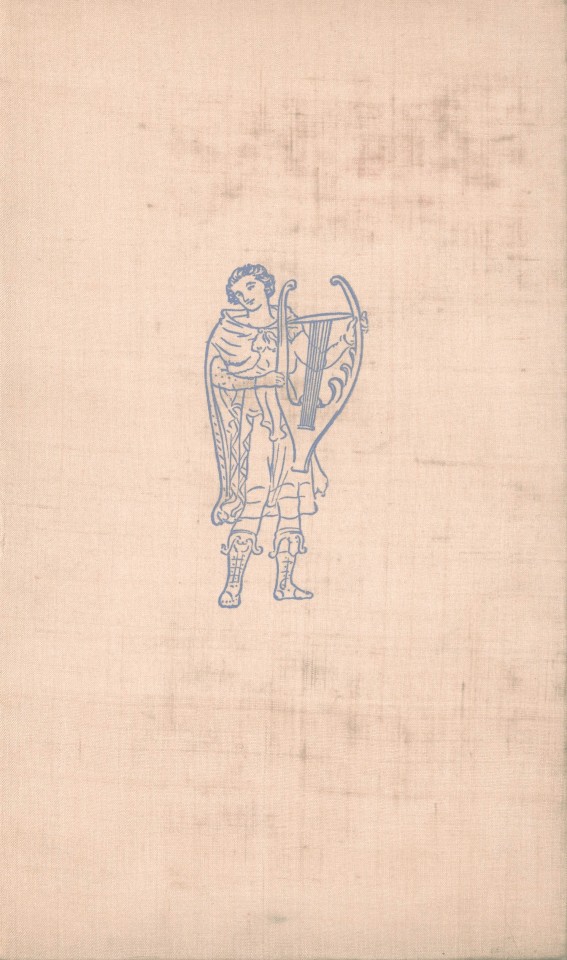
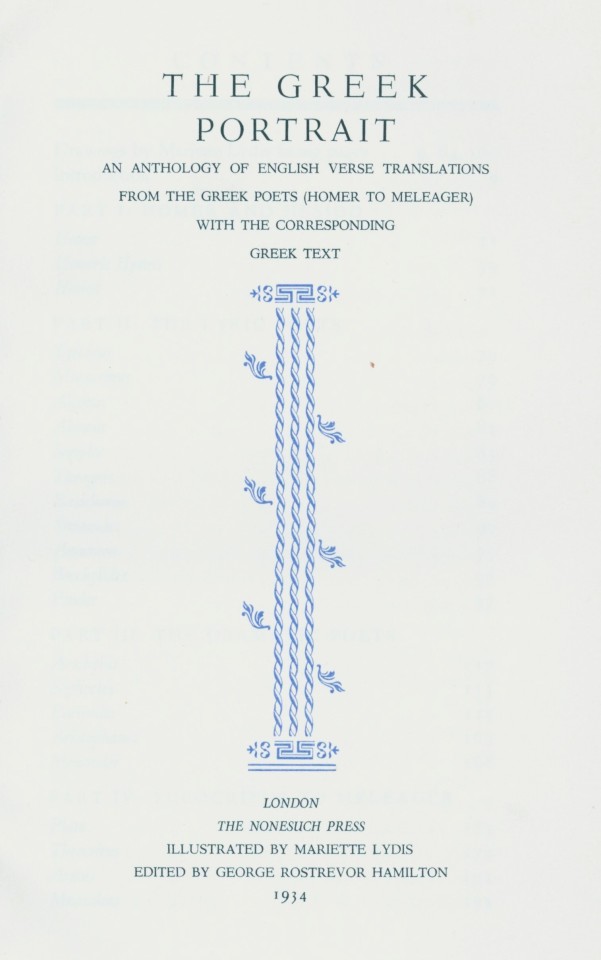
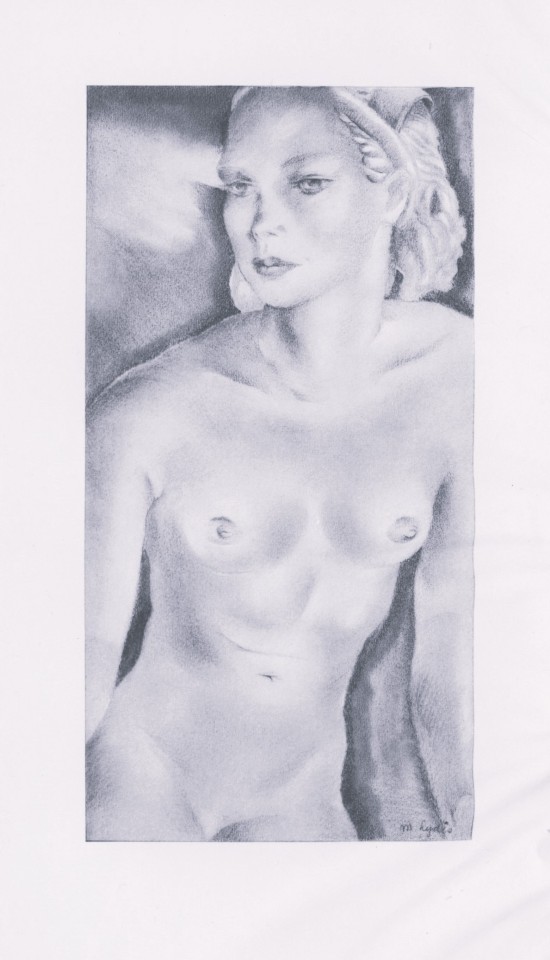
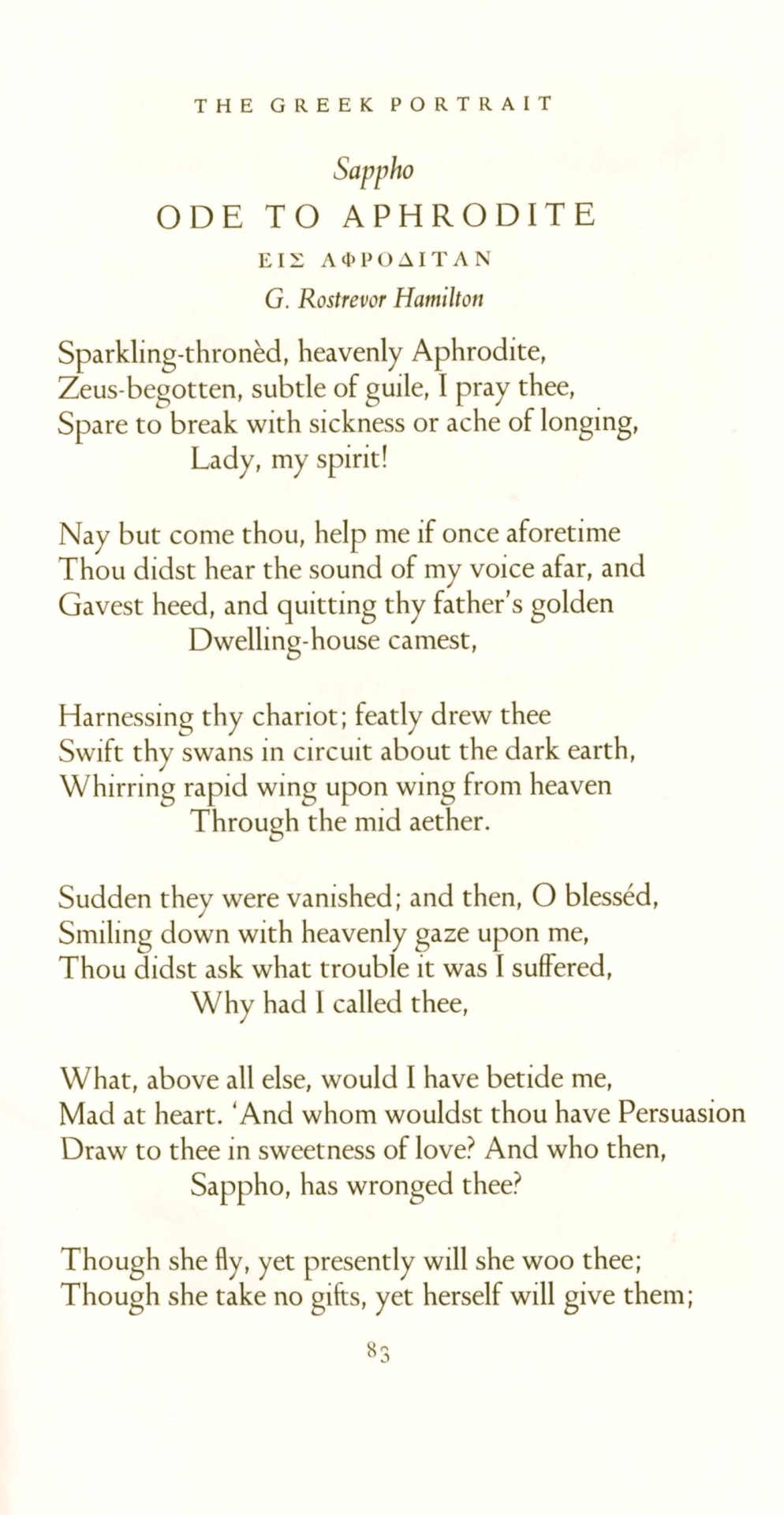
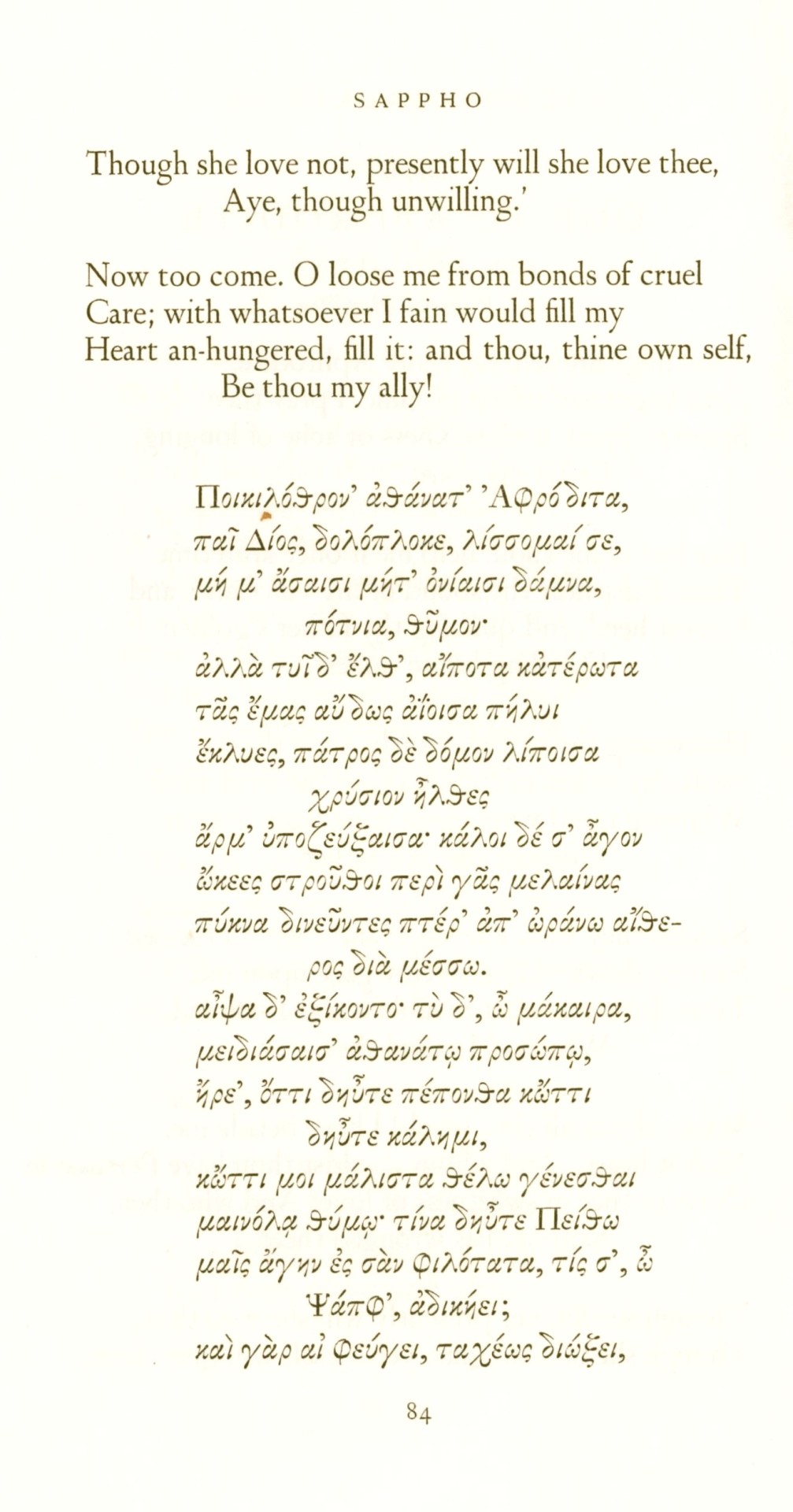
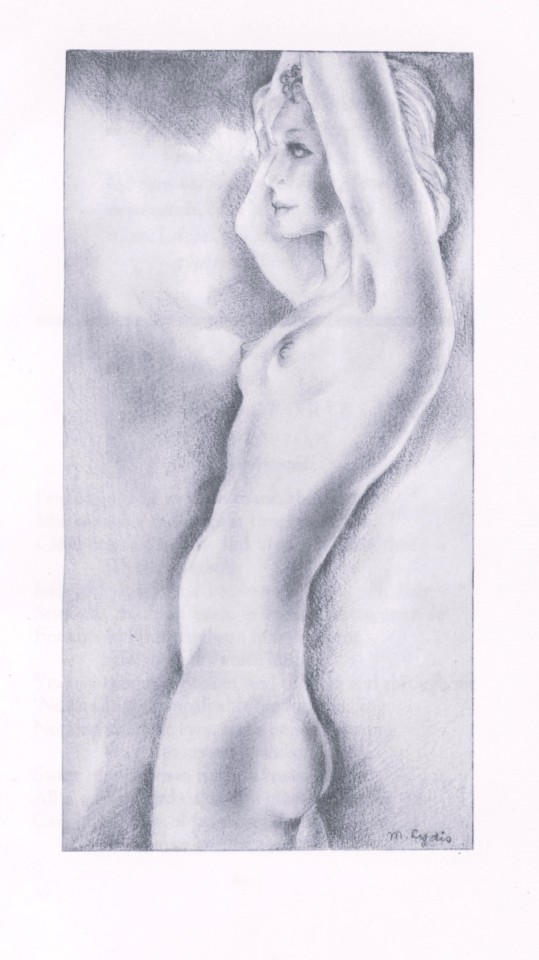
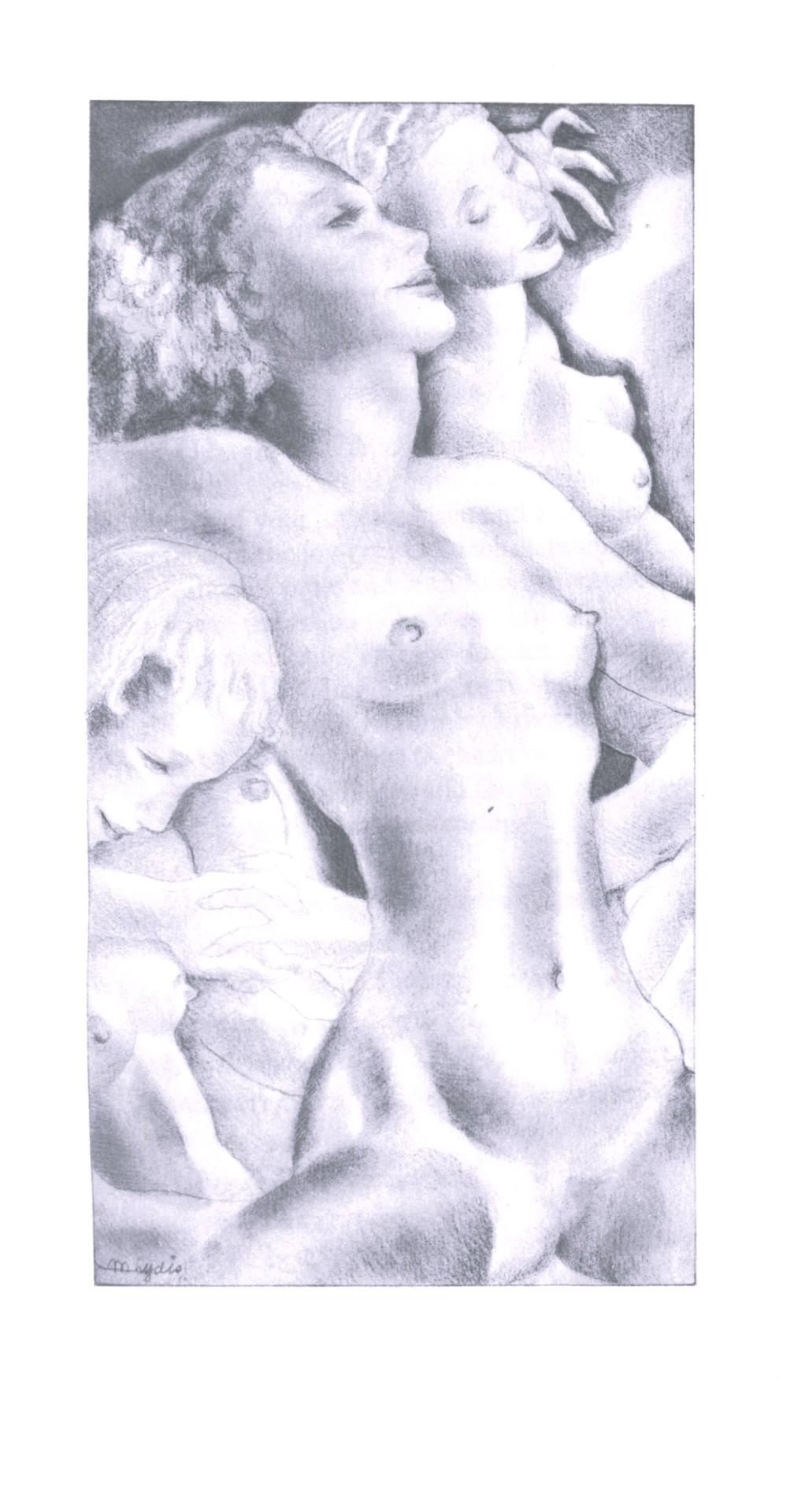
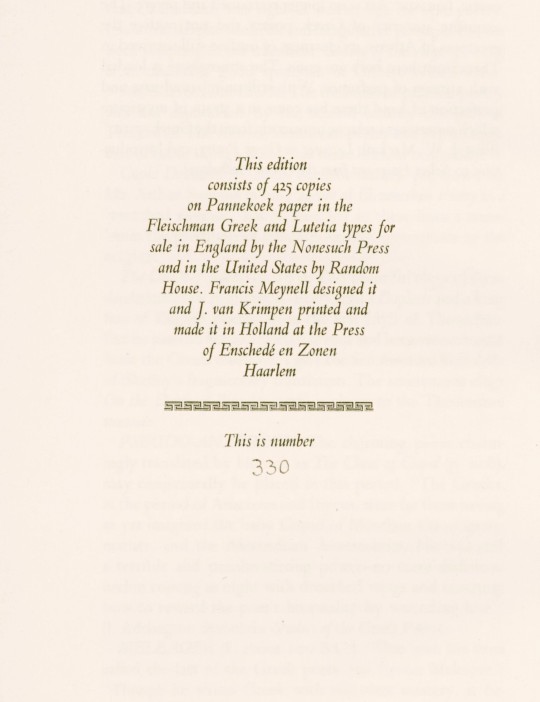

It's Fine Press Friday!
A Classic Representation
The Greek Portrait is an anthology of English verse translations of eminent Greek poets, from Homer to Meleager, with the corresponding Greek text presented alongside. Numerous translators provided the translations, taking on the arduous task of translating essential works from the Classical Period, including epic, lyric, and dramatic poetry.
This 1934 edition was designed by British fine-press publisher Francis Meynell (1891-1975) and printed in an edition of 425 copies by Dutch book and type designer Jan van Krimpen (1892-1958) at the Press of Enschedé en Zonen in Haarlem for Meynell's Nonesuch Press in London. The text was edited by English poet and critic George Rostrevor Hamilton (1888-1967) and printed on Pannekoek paper in Fleischman Greek and van Krimpen's Lutetia types.
The illustrations are by Mariette Lydis (1887-1970), an Austrian-Argentine painter known for her portraits, illustrations, and erotic engravings. She was a self-taught artist who began her career at a young age and had a history of creating what was considered controversial artwork during her lifetime. She gained recognition for creating lithographic depictions that celebrated lesbian and bisexual relationships. However, some critics of her work described the illustrations as "perverse.” We find these prints to be quite lovely, however.
-Melissa, Special Collections Classics Intern
View another post with illustrations by Mariette Lydis.
View our other posts with books from the Nonesuch Press.
View other Classics posts.
#classics#Nonesuch Press#The Greek Portrait#ancient greek#greek#greek poetry#Greek poets#Mariette Lydis#Francis Meynell#Jan van Krimpen#Joh. Enschedé en Zonen#Enschedé#George Rostrevor Hamilton#illustrations#english translations#epic poetry#lyric poetry#Fleischman Greek type#Lutetia type#Pannekoek paper#classical period#classical literature#anthologies#fine press books#fine press publishing#so dramatic#melissa
66 notes
·
View notes
Link
In de laatste aflevering van de serie 'Haarlemse Iconen' staat het oudste bedrijf van dit seizoen centraal: Koninklijke Joh. Enschedé. Opgericht in 1703, heeft dit bedrijf een rijke geschiedenis op het gebied van beveiligd drukwerk. Van kleinschalige drukkerij tot wereldleider in beveiligd drukwerk Izaak Enschedé begon in 1703 een kleinschalige drukkerij in Haarlem, samen met zijn zoon Johannes - naar wie het bedrijf vernoemd is. De kleine drukkerij groeide uit tot de officiële drukker van de stad Haarlem en produceerde wat nu een van de oudste kranten ter wereld is. In 1810 drukte Joh. Enschedé de eerste bankbiljetten voor gebruik in Nederlands-Indië en de West-Indische gebieden, gevolgd door de eerste Nederlandse bankbiljetten in 1814. Marcel Klok over de geschiedenis van Joh. Enschedé In de aflevering gaat presentator Rudy Nicola o.a. in gesprek met Marcel Klok, Sales Director bij Koninklijke Joh. Enschedé. Marcel vertelt over de beginjaren van de drukkerij, de bepalende momenten in de geschiedenis van het bedrijf en hoe Joh. Enschedé specialist werd in het drukken van bankbiljetten. En een opvallende anekdote over Walt Disney. Verhuizing naar de Waarderpolder en groei tot marktleider Na bijna 300 jaar gevestigd te zijn geweest aan het Klokhuisplein, verhuisde het bedrijf in de jaren 1980 naar de Waarderpolder. Van 1900 tot 2000 groeide het bedrijf uit tot een marktleider op het gebied van hoogwaardig beveiligd drukwerk, met de productie van nieuwe producten als cheques, visa, belastingzegels en certificaten. Joh. Enschedé werd een van de eerste drukkers van eurobankbiljetten. De toekomst van Joh. Enschedé In de aflevering wordt ook vooruitgeblikt op de toekomst van Joh. Enschedé. Het bedrijf staat midden in de transitie van klassiek drukwerk naar de digitale economie. Ondanks dat het drukken van bankbiljetten niet helemaal is verdwenen, wordt er volop geïnnoveerd. Zo werd er vorig jaar een speciaal tientje gedrukt voor Nick & Simon, met een koppeling naar Augmented Reality. Waar en wanneer? De aflevering over Joh. Enschedé is vanaf vrijdag 27 oktober vanaf 18.00 uur te zien op Haarlem105-TV en wordt de hele week herhaald. Ook zijn de afleveringen te zien via het YouTube-kanaal van Haarlem105. Dit is de laatste aflevering van het 1e seizoen van Haarlemse Iconen. Laatste aflevering van 1e seizoen De aflevering over Koninklijke Joh. Enschede is de laatste van het 1e seizoen van Haarlemse Iconen. In dit seizoen stonden naast Joh. Enschede, ook Dansschool Schröder, Proeflokaal de Blauwe Druif, Hotel Lion D’or, Feestwinkel Jan Monnikendam en Van der Pigge in de spotlights. Presentator Rudy Nicola zegt: "Ik heb al jaren de ambitie gehad om een programma te maken over de oudste bedrijven van Haarlem. Ik kom er al mijn hele leven, maar stond er nauwelijks bij stil welke geschiedenis erachter schuilt. Als kijker krijg je een uniek inkijkje in deze 'Haarlemse iconen'. Het was een eer om te maken. Ik kijk nu al uit naar het 2e seizoen."
0 notes
Text
The Christmas Experience in het Vikingschip in Den Oever
Er op uit: 'The Christmas Experience in het Vikingschip in Den Oever'
DEN OEVER – De Koninklijke Joh. Enschedé (drukkerij van postzegels, waardepapier, voorheen de gulden bankbiljetten) is hoofdsponsor van de Stichting The Christmas Experience. The Christmas Experience is een show orkest welk een anderhalf uur durende kerstshow produceert en uitvoert. De entreeprijs is op verzoek van de sponsor zeer laag met € 12,50 (incl. consumptie). De show vindt slechts plaats…

View On WordPress
0 notes
Photo
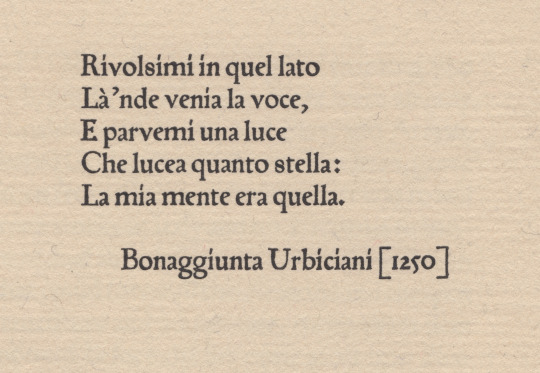
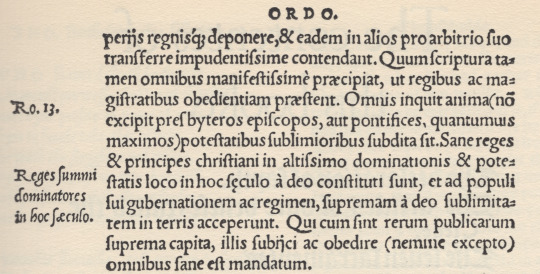
not schöffer’s roman
peter schöffer of gernsheim [1425-1503] was a scribe who apprenticed to the inventor of the black art, johannes gutenberg. schöffer united with gutenberg’s partner, johann fust, in legal proceedings against gutenberg resulting in «appropriation» of guntenberg’s printing apparatus; after which he married fust’s daughter, christina, & articled with fust in a new printing office—fust & schöffer. urbiciani’s poem [1st illustration*] prefaces a little book entitled Hand and Soul by dante gabriel rossetti [the halcyon press, maastricht, 1928]: it is set in types attributed to schöffer—which would have been amongst the first transalpine romans. the matrices descended schöffer’s family until jacobus scheffers, a printer at bois-le-duc [’s-hertogenbosch], sold them to johannes enschedé on 26 august 1768—enschedé used them only for study. the book is set in a fount cast by the historic firm of joh. enschedé en zonen, haarlem, in the early 20th c., from the restored material [ibid., colophon]. however, we learn from a.f. johnson: «One roman of this class has survived to our day, and is part of the wonderful collection of early types owned by Enschedé of Haarlem. In the specimen of this roman issued in 1926 they attribute it to Peter Schöffer of Mainz, and consider it to be the oldest type in their collection. It came to the Haarlem firm in 1768 from one Jacobus Scheffers, a printer at Bois-le-Duc, a descendent of the Schöffers. Their dating of the type is too early, but it is at least early sixteenth century. It is first found at Cologne in 1527.» [Type Designs, grafton & co., london, 1959, p.44]. johnson further directs us via footnote [ibid.] to A History of the Old English Letter Foundries by talbot baines reed (edition edited & expanded by johnson) who puts us firmly in the picture: «Thomas Berthelet, who succeeded Pynson as King’s printer in 1530, introduced two, or possibly three, new romans and an italic from Cologne, where there was an anonymous punch-cutter at work in the twenties, one of whose designs has survived to our generation. Whether he worked as an independent founder or was an employee of one of the leading Cologne printers, Quentel or Cervicorn, cannot be discovered. … The 88 roman [2nd illustration†] is found at Antwerp with J. Steelsius in 1539. This type seems to have some relation to Quentel’s roman first found in 1527, a type which has survived, at least in part.» [faber&faber, london, 1952, pp 87-8]. the textile research centre in leiden has an interesting page about peter quentel & his activity in 1527.
* printed letterpress on van gelder mould-made paper in the office of joh. enschedé en zonen.
† frank isaac, English & Scottish Printing Types 1535–58 * 1552–58, the bibliographical society, 1932, fig. 4.
#typography#letterpress#peter schöffer#poetry#bonaggiunta urbiciani#joh. enschedé en zonen#thomas berthelet#peter quentel#alfred forbes johnson#talbot baines reed
0 notes
Photo
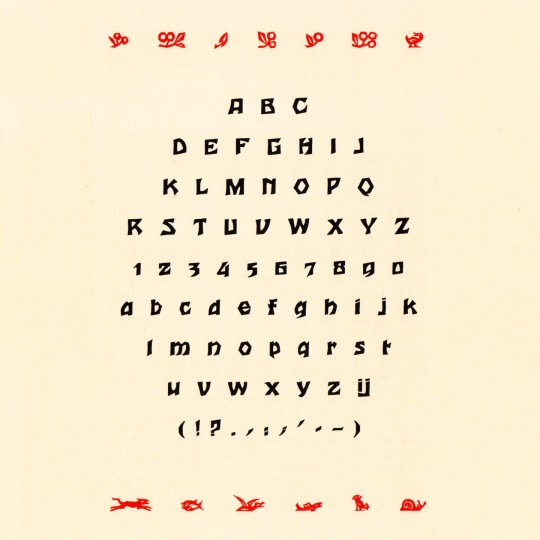
Houtsneeletter, André van der Vossen for Joh. Enschedé en Zonen, 1927 #woodcut #typespecimen
4 notes
·
View notes
Text
INFO LOWONGAN KERJA BUMN PERURI JAKARTA PUSAT
INFO LOWONGAN KERJA BUMN PERURI JAKARTA PUSAT
BRITAKERJA ID – Perusahaan ini memulai sejarahnya sebagai PT Percetakan Kebayoran (Perkeba) yang berbisnis di bidang percetakan uang kertas dan PN Arta Yasa yang berbisnis di bidang percetakan uang logam. Perkeba didirikan sebagai bentuk kerja sama antara Pemerintah Indonesia dengan Joh. Enschedé asal Belanda, namun Pemerintah Indonesia hanya memegang minoritas sahamnya. Pada tahun 1959, Perkeba…
View On WordPress
0 notes
Photo

The Indonesia Post Administration was formally established on 27 September 1945, but the history of Indonesian stamps began on 1 April 1864 with the release of the first Dutch East Indies stamp. The history of Indonesian stamps can be divided into five broad periods: • The Dutch East Josh Twigger • The Japanese Occupation • The War of Independence • The Beginning of Independence • The New Order and present The first postage stamp in the Dutch East Indies was printed in Utrecht, the Netherlands, on 1 April 1864. The stamp showed a picture of King Willem III of the Netherlands and had a face value of ten cents. It was designed by T W Kaiser. Until 1920, stamp designs only showed pictures of the King and Queen and were primarily shown using typographic design. In 1921, a new series known as the ‘Brandkast’ series [Wikidata] and was specially printed to serve as additional postage for sending sea mail in waterproof iron chests. Stamps issued in later years began to show the culture and geography of the Indonesian archipelago. During the Dutch East Indies period, the stamps were printed in the Netherlands by the firm of Joh. Enschedé & Zoner of Haarlem, and some printing was done in Batavia (Jakarta) by Reproductiebedrijf Topografische Dienst. The stamps were mostly printed in one or two colors. Source: Wikipedia www.facebook.com/StampSellersBKI #stamps #philategram #stamp #gogreen #filatelia #prangko #philately #worldstamp #philatelie #philatelist #natural #postzegels #august #oldstamps #stampsellers #selos #love #stayhome #shotoniphone #stampscollection #postales #indonesia #cents #Kemerdekaan #borobudur #java #марки #オランダ #netherlands https://www.instagram.com/p/CDRyaiwJKBu/?igshid=1va8ttcidqjvq
#stamps#philategram#stamp#gogreen#filatelia#prangko#philately#worldstamp#philatelie#philatelist#natural#postzegels#august#oldstamps#stampsellers#selos#love#stayhome#shotoniphone#stampscollection#postales#indonesia#cents#kemerdekaan#borobudur#java#марки#オランダ#netherlands
0 notes
Link
0 notes
Text
After leaving the school de Does was hired as the typographic caretaker at Joh. Enschedé en Zoden in Haarlem in 1958 and stayed there, with only a short break in employment, until 1988.
0 notes
Text
[retypefoundry] Gorgeous picture of Rädisch (or maybe Drost) cutting a punch at Joh. #Enschedé foundry. Don't miss the coming Joh.… https://t.co/145CcrmIuX
Retype Foundry @retypefoundry Gorgeous picture of Rädisch (or maybe Drost) cutting a punch at Joh. #Enschedéfoundry. Don't miss the coming Joh.… twitter.com/i/web/status/1… from Twitter favorites feed for typemytype https://twitter.com/retypefoundry/statuses/1192808086299381760
0 notes
Text
Joh. Enschedé neemt startup AntTail over
Grafisch dienstverlener Koninklijke Joh. Ensched�� uit Haarlem neemt AntTail over. Die startup uit Utrecht levert sensoren en bijbehorende cloudoplossingen voor het monitoren van de logistieke in de farmaceutische markt. Via deze overname voegt Joh. Enschedé beveiligingsoplossingen... http://dlvr.it/QWTbgd
0 notes
Text
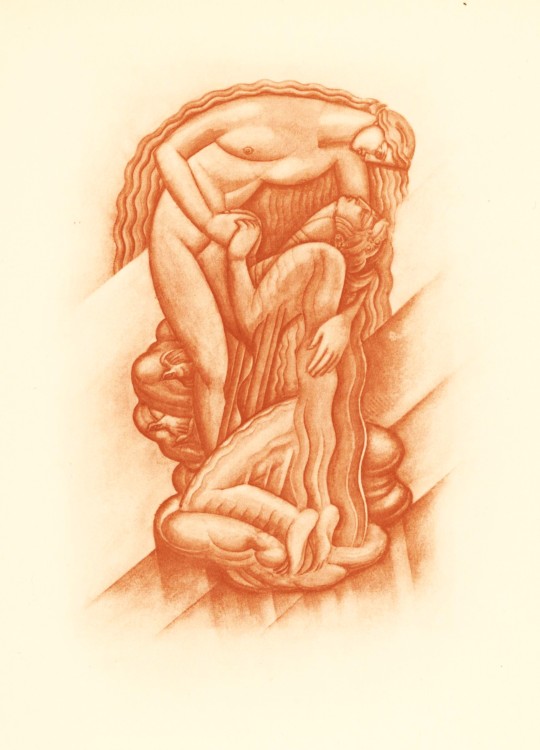
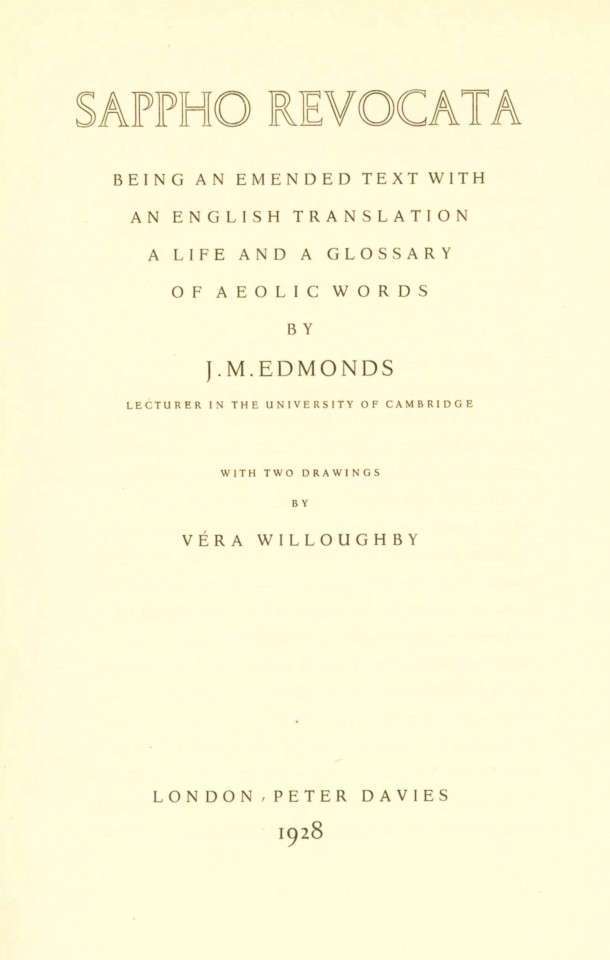
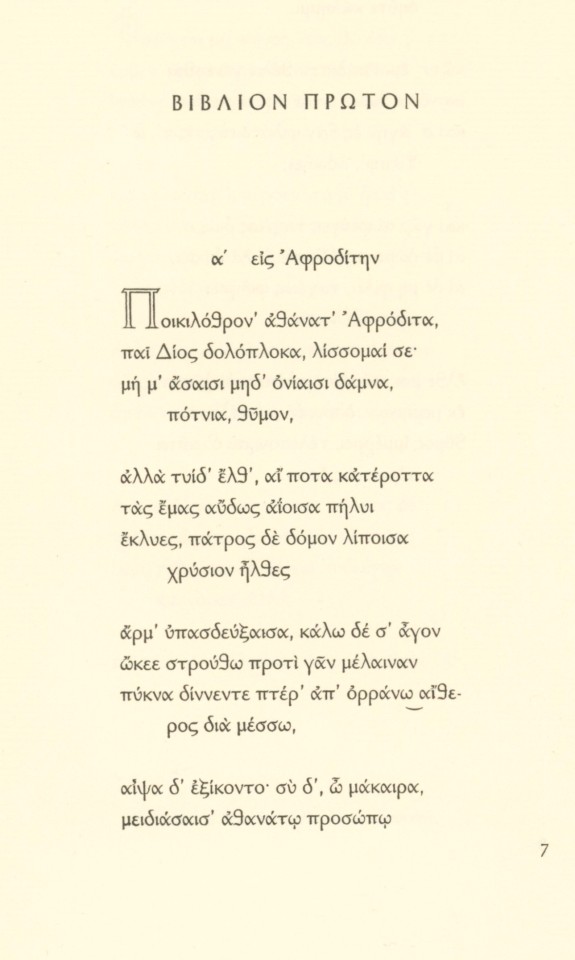
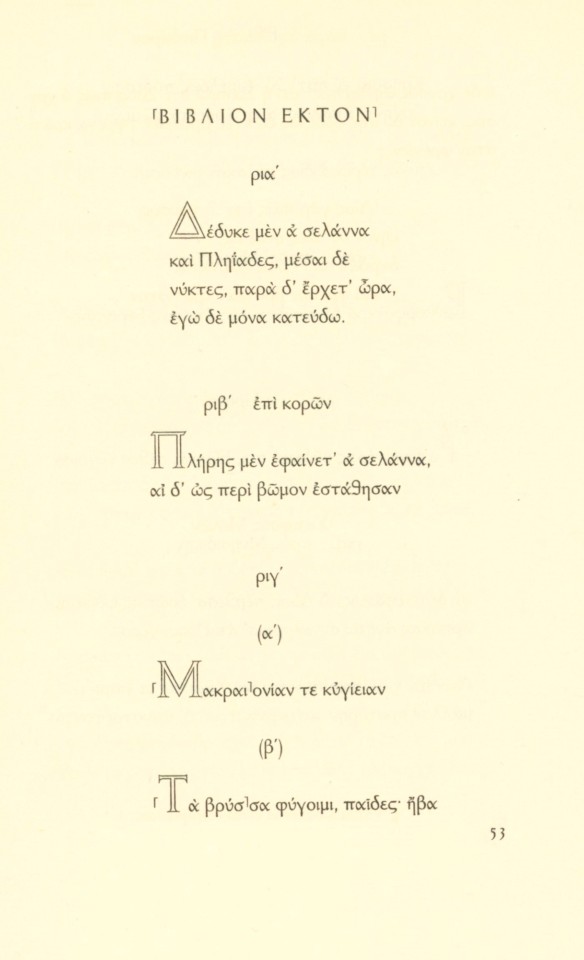


It's Fine Press Friday!
On this Fine Press Friday we present a collection of poems by Sappho entitled Sappho Revocata, compiled and translated by poet, English classicist, and Cambridge lecturer J.M. Edmonds with two drawings printed in collotype by British artist Véra Willoughby, and published in 1928 by Peter Davies in an edition of 350 copies.
Sappho Revocata includes Sappho’s complete and fragmentary poems in two sections; the first half records her poetry in Greek, while the second half has the corresponding English versions of the same works. Sappho is particularly lauded in popular culture for her frequent discussion of romantic love between women. Her poetry was so admired in the ancient world that Plato referred to her as “the tenth muse” in his writings.
This book is the first to use Jan van Krimpen’s Greek type Antigone, with his Lutetia type for the preliminary pages and English section of the text. It was printed by the distinguished Dutch printing house of Joh. Enschedé en Zonen in Haarlem, Holland. The two illustrations by Véra Willoughby were printed at the Chiswick Press in London. 150 copies were reserved for the United States and distributed by Random House.
Our copy, another gift from our friend Jerry Buff, bears the bookplate of Joan Whitney. We're not sure who that may be, but we know this copy was acquired in New York, so we're hoping that it belonged to American heiress, art collector, and co-founder and former majority owner of the New York Mets, Joan Whitney Payson (1903-1975).
View more Fine Press Friday Posts.
– Sarah S., Special Collections Graduate Intern
#fine press friday#sappho#poetry#greek#sappho revocata#vera willoughby#j.m. edmonds#peter davies#collotype#Jan van Krimpen#antigone#antigone type#lutetia#lutetia type#Joh. Enschedé en Zonen#joh. enschede#chiswick press#Sarah S.#fine press#fine press books#fine press printing#fine press fridays#Jerry Buff
22 notes
·
View notes
Link
Diploma Support biedt een alles-in-één serviceplatform voor het bestellen, produceren en afleveren van diploma’s voor onderwijsinstellingen. Gemak staat voorop, met de belofte dat het gehele logistieke proces is beveiligd. De innovatieve diplomaservice is een product van Royal Joh. Enschedé in samenwerking met Prindustry. Elk jaar studeren duizenden studenten af. Ze ontvangen hun diploma samen met een cijferlijst in een fraaie diplomamap. Een mooi bewijs voor de student, maar veel werk voor examencommissies. Diploma Support maakt dit diplomaproces eenvoudiger. Met Diploma Support organiseert een onderwijsinstelling het hele traject vanaf één platform. Elke universiteit, HBO of MBO krijgt een snelle en veilige manier om online diploma's te genereren, te bestellen en te verzenden. Adriaan Kamphorst, Royal Joh. Enschedé: “We bieden een optimaal beveiligd proces voor het hele diplomatraject. Van opmaak en bestellen tot printen en afleveren. Elk document is voorzien van geavanceerde beveiligingsmaatregelen, zoals een microtekst in de digitale handtekeningen. De waardedocumenten leveren we via beveiligd transport af op de gewenste locatie. In slechts een paar stappen ontvangt de onderwijsinstelling zo alle persoonsgebonden diploma’s. En dat altijd binnen de strengste veiligheidskaders. Diploma Support waarborgt onvervalsbare diploma’s.” Voor de automatisering van dit diplomaproces is Royal Joh. Enschedé een samenwerking aangegaan met softwareontwikkelaar Prindustry. Prindustry heeft alle onderdelen van het proces in één platform ontwikkeld. “Medewerkers die toegang krijgen tot het platform, kunnen de gewenste diploma’s en bijbehorende documenten online selecteren”, vertelt Ramon van Wingerden van Prindustry. "Wanneer er een bestelling wordt geplaatst, worden alle studentgegevens gekoppeld aan de diploma's. Er volgt een PDF die ter goedkeuring naar de toegewezen medewerkers gaat. De goedgekeurde bestanden gaan vervolgens in productie bij Royal Joh. Enschedé. Zo zetten we samen met Diploma Support een innovatief en zeer veilig product neer. 100% gemak en toch veilig!"
0 notes
Text
ML gaat XXL
AANWINST VOOR HAARLEM Medio maart verhuisde het sterrenrestaurant ML naar het Klokhuisplein aan de voet van de St. Bavokerk in Haarlem. Het monumentale 18e -eeuwse pand van de voormalige drukkerij en lettergieterij van Koninklijke Joh. Enschedé. Werd het nieuwe onderkomen. De plek waar ooit Stempels zat. ML Haarlem. Hét pand aan het Klokhuisplein. ‘Fotografie: René van Dongen Fotografie’ Het…
View On WordPress
0 notes
Photo

caxton
«Printing [typography] was introduced in England in 1476 by William Caxton, who owes his fame, however, to more than the fact that he was England’s proto-typographer. For he was not only the first of English printers—he was also ‘the first in a long line of English publishers who have been men of letters … and was likewise one of the earliest in the succession of English merchants and men of affairs who have found recreation and fame in the production of literature’.» [d.b. updike, Printing Types, vol. 1, oxford university press, 1937, p113; updike is quoting from a paper by george parker winship: William Caxton, doves press, 1909]. it is a misnomer referring to caxton as printer—conjures images of setting type & pulling prints: he was a printer in the sense that he owned a printing establishment; but his press was for him a means to effect trade—he was his whole life a professional merchant. severin corsten in his paper «Caxton in Cologne» gives strong argument, deduced from the misty history surrounding caxton’s acquisition of the black art, that the city of cologne occasioned caxton’s close study of this new technology while seeing an edition of bartholemew’s De Proprietatibus Rerum through the press in johann veldener’s printing office (veldener had learned the art in the office of ulrich zell—cologne’s first printer); caxton may have also materially participated in this publication [Journal of the Printing Historical Society, No.11, 1975/6]. caxton set up his first office at bruge in 1472, where he issued the first printed, english language book in 1474, his first literary translation, Recuyell of the Historyes of Troye. finally, caxton removed back to london in the autumn of 1476 with apparatus & assistant, wynkyn de worde, establishing his office within the precincts of westminster abbey.
richard deacon [donald mccormick] tells us in his interesting book William Caxton the First English Editor [frederick muller, london, 1976, p92]: «It is clear that Caxton had a passion for the English language, for developing it and for changing it from a hotchpotch of dialects to a cohesive, expressive force.» caxton lamented the kentish weald dialect of his upbringing: «He was for ever striving after changing what he called ‘the rude and old Englyssh’.»* [ibid., p55]. deacon’s book is set throughout in monotype van dijck [english monotype 203]—inspiration for setting caxton’s locution in monotype’s digital reissue of van dijck italic. monotype van dijck italic is jan van krimpen’s 1937-8 adaptation of the Augustijn Romeyn italic cut by christoffel van dyck, as shown on the 1681 specimen issued as a sales catalogue by the widow of daniel elsevier, in amsterdam [stanley morison, A Tally of Types, cup, 1973, appendix p113 ]. the punches for van dyck’s founts passed down by sale through several foundries, finally again reuniting in 1799 in the famed amsterdam foundry joh. enschedé en zonen [ibid., p115].
digital print [toner] on cartiera amatruda amalfi.
*full context: «[I] somwhat have chaunged the rude and old Englyssh, that is to wete certayn wordes which in these dayes be neither usyd ne understanden» [cf. n.f. blake, Caxton and his World, andre deutsch, london, 1969, p181].
#english#literature#typography#caxton#typesetting#johann veldener#christoffel van dyck#jan van krimpen
3 notes
·
View notes
Photo
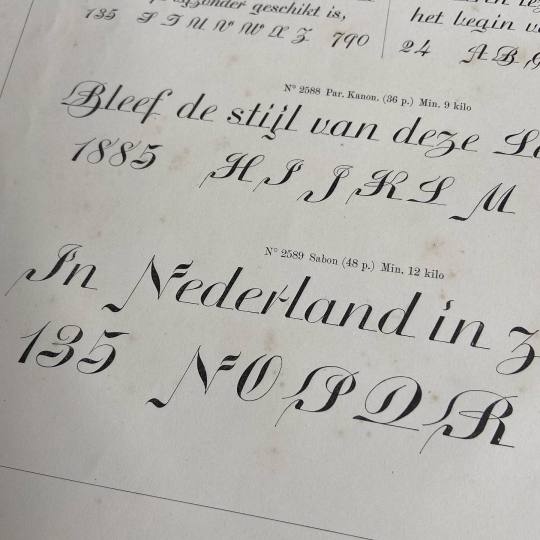
Joh. Enschedé & Zonen, Haarlem, 1889 #typespecimen
4 notes
·
View notes